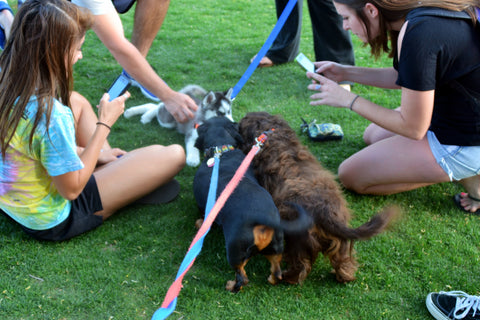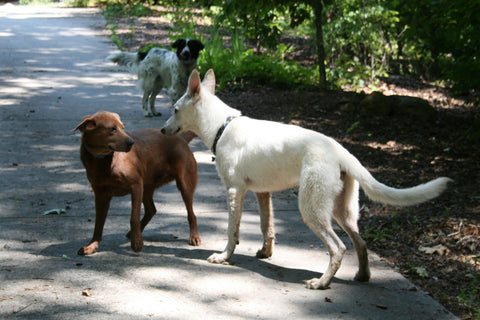There's plenty of people that look at Griffey and ask...'Wow he's really well behaved. Where did you get him trained?" The truth is I didn't take him anywhere...there's no quick tips or tricks I can give you. Just like anything that's fruitful in this life, it came with a lot of hard work and persistence (as well a dump truck full of treats).
When it comes to socializing your dog there are a few things you can do to make him more accepting and friendly towards other dogs.

Just like the age old saying 'You can't teach an old dog new tricks.'...which from an owner of a 11 year old is pretty damn on point I must say...it certainly helps to start teaching your dog at a younger age. As with humans, dogs don't know any better than to be open and accepting of new experiences and stimuli in their lives when they are puppies. As they grow older that's when they, again like humans, remember and apply some of their past experiences...and/or become less accepting of new things.
What you want to do from day 1 is not throw you dog into a pack of dogs...because that could scare/scar him going forward...but slowly introduce him to other friendly dogs. Every day on your walk get him acquainted with the introduction, the smelling process, and ensure that it's a normal, positive experience for him. The more often he experiences this from a younger age, the more he will grow up accustom and comfortable with other dogs.

Practice makes perfect. We've said this in a few of our other blog posts, but dogs are not like humans in that their mental capacity is that of toddlers. Drawing cause and effect conclusions for dogs is a lot more difficult when the conditioning behavior/experience happens once a week. As owners it's our responsibility to ensure we introduce enough stimuli in their lives to enable these conclusions...the lightbulb!
For socialization, this means ensuring you put your dog within the presence of other dogs often enough to get him acclimated. For most of us running into other dogs is inevitable, but for some of you in more rural areas you may need to seek out different local dog friendly parks or hikes to put your dog in the place where he can meet other dogs.
Remember, the dogs that are sitting behind a window barking or trying to snap their leash in half to come after you have not been socialized well enough...in some cases it's tough to seek out and find dogs for your puppy to socialize with. But in the end it's better than having the embarrassing psycho dog in the neighborhood.

One of the factors to take into consideration when you're introducing any new dogs, especially aggressive and/or territorial dogs, is where they're meeting. Most dogs are territorial and protective over their space...so number 1 is take them out of that environment. A park or even a quiet neighborhood sidewalk is usually sufficient enough of a place to eliminate any territorial behavior that may inhibit friendly socializing.
As always, your dog's behavior is a direct result of how you train and lead your dog. This involves a few things when introducing your pup to another dog. First, confidence is key...if you act timid your dog will pick up on your body language and he's going to be timid, on edge, and more likely to snap.

Secondly, the way you hold the leash will subconsciously affect the way your dog pulls...ever seen a guy in a fight...seems like when he's suddenly being held back he wants to push and push and get to the other guy even more right? Same thing is true with dogs...if there is no slack on the leash and they're 6' away from you pulling on the leash and you're pulling back...it's only going to instinctively want to pull harder which perpetuates the problem. Keep your dog close by your side no more than 2 feet away...ideally you want to use a short lead and have a secure, but loose grip. This will instill confidence in your dog allow him to be comfortable while approaching another dog.

This is about leadership and positive repetition. What you want to do is not only speak to your dog in a calm soothing confident manner, but if you also approach and exude that equivalent body language to the other dog...your dog picks up on it...and it again instills that ease and friendliness into him. At the same time after you turn away and continue on your way, as with all positive behaviors, make sure to positively reinforce his behavior. This will continue to reinforce and strengthen that "Hey making friends is good!". And at the end of the day you want to be with that dog...not the grumpy loner that's barking behind a window.
Reynold Krieg
Mar 03, 2017